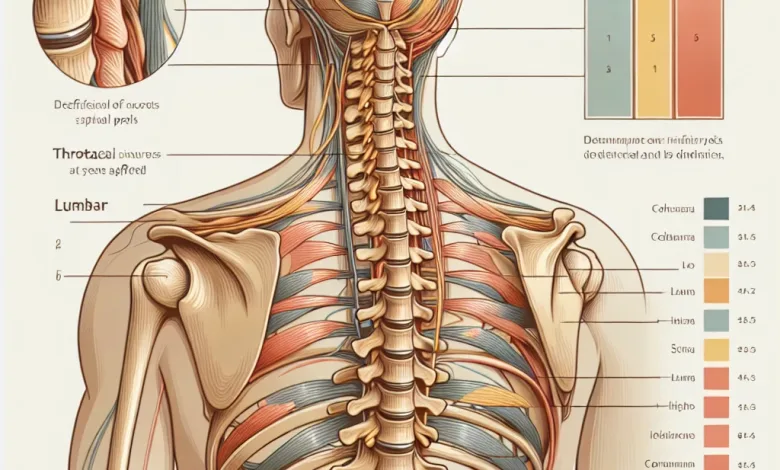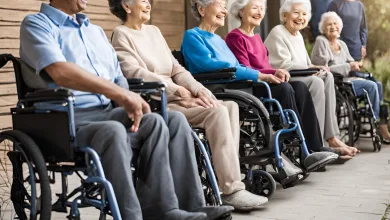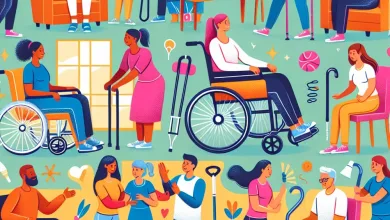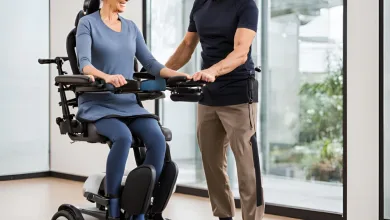Understanding Spinal Cord Injury Functional Levels: Taking Charge of Your Recovery

Table of Contents
Demystifying Spinal Cord Injury Functional Levels
Think of your body as a sophisticated highway network, transmitting messages between your brain and muscles. A Spinal Cord Injury (SCI) disrupts this network, impacting your movement, sensation, and bodily control. The extent of these impacts hinges on the injury’s location and severity. This is where understanding Spinal Cord Injury Functional Levels becomes crucial.
Levels of Spinal Cord Injury
Doctors classify SCIs based on the neurological level of the injury, which is the lowest point on the spinal cord where normal function is lost. This classification system helps predict potential functional abilities and guide Spinal Cord Injury Rehabilitation. Here’s a breakdown of the primary levels:
High-Cervical Nerves Injury (C1-C4):
Injuries at the top of the spinal cord affect all four limbs and breathing muscles. Individuals with these injuries may require a ventilator and rely heavily on assistive technology like sip-and-puff controls for wheelchairs and communication devices.
Low-Cervical Nerves Injury (C5-C8):
Some arm and hand functions might be preserved here. People with these injuries may be able to operate a power wheelchair for Spinal Cord Injury with adapted controls and perform some daily tasks with assistance.
Thoracic Vertebrae Injury (T1-T12):
Injuries in the chest area primarily affect the torso and legs. Individuals may have some trunk control and use adaptive equipment for SCI, like leg braces to walk short distances.
Lumbar Nerves Injury (L1-L5):
These injuries typically affect leg movement and bowel/bladder control. People with these SCIs often regain some leg function with mobility training and can use walkers or wheelchairs for increased independence.
Important to Remember: While this is a general overview, functional ability after a Spinal Cord Injury can vary greatly. Some individuals with higher-level injuries may experience significant recovery, while others with lower-level injuries may face greater challenges.
Beyond Levels: Building a Life After SCI
Spinal Cord Injury Rehabilitation is a crucial part of the recovery process. It involves a team of specialists improving mobility, strength, and independence. Rehabilitation programs can include:
- Physical Therapy: Helps regain strength, coordination, and movement skills.
- Occupational Therapy: Teaches daily living skills like dressing, bathing, and cooking with adaptive equipment.
- Speech Therapy: Addresses communication difficulties caused by the injury.
- Psychological Support for SCI: Helps individuals cope emotionally with the impact of the injury.
Taking Charge of Your Recovery
While the road to recovery might be extended, there are ways to take charge and live a fulfilling life after SCI. Here are some tips:
- Set realistic goals: Work with your rehabilitation team to set achievable goals that motivate you.
- Explore assistive technology: Power wheelchairs, standing wheelchairs, voice-activated devices, and other tools can significantly improve independence.
- Stay active: Mobility training and regular exercise programs can improve physical and mental well-being.
- Connect with support groups: Sharing experiences with others who understand your challenges can be invaluable.
Empowering Technologies:
Advances in technology are constantly improving the lives of people with SCIs.
- Power Chair Benefits: These chairs offer superior customization and maneuverability, making them ideal for navigating different terrains.
- Standing Wheelchair Features: Standing wheelchairs allow individuals with lower-level injuries to experience the benefits of being upright, improving circulation and overall well-being.
Looking Forward with Confidence
Understanding Spinal Cord Injury Functional Levels is a starting point, but it doesn’t define your future. Dedication, rehabilitation, and suitable support systems allow you to regain control and live a vibrant life after SCI.
Unique Challenges and Opportunities at Each Level
While the above provides a general framework, let’s delve deeper into some unique challenges and opportunities associated with each Spinal Cord Injury Functional Level:
High-Cervical Injuries (C1-C4):
- Challenges: Individuals with these injuries require constant care and may face difficulty breathing, speaking, and controlling body temperature.
- Opportunities: Advances in respiratory technology and communication devices offer greater independence. Speech-generating devices and sip-and-puff controls allow for communication and environmental control.
Low-Cervical Injuries (C5-C8):
- Challenges: Limited hand and arm function can make daily tasks difficult.
- Opportunities: Adaptive equipment for SCI, like dressing sticks, specially designed utensils, and voice-activated controls, can significantly enhance independence. Occupational therapy is crucial in teaching individuals how to perform daily activities with adaptive equipment.
Thoracic Vertebrae Injuries (T1-T12):
- Challenges: Balance and core strength can be impaired, making transfers and mobility difficult.
- Opportunities: Mobility training programs can help strengthen core muscles and improve balance. Complex rehabilitation chairs with trunk support and advanced features can offer greater mobility and independence.
Lumbar Nerves Injury (L1-L5):
- Challenges: Regaining bowel and bladder control can be a challenge.
- Opportunities: Spinal Cord Injury Rehabilitation programs can teach bowel and bladder management techniques. Technological advancements in catheters and other medical devices can improve quality of life.
Remember: This is not an exhaustive list; experiences can vary greatly. It’s essential to consult with your healthcare team to understand your specific challenges and opportunities for maximizing your recovery and independence.
Living a Fulfilling Life After SCI: It’s All About You
Spinal Cord Injury Functional Levels provide a roadmap, but your journey is unique. Here are some key takeaways:
- Focus on your potential: Don’t be defined by your injury. Focus on what you can achieve and work towards your goals.
- Embrace a positive attitude: A positive outlook can significantly improve your recovery and overall well-being.
- Seek support: Surround yourself with supportive loved ones, healthcare professionals, and support groups.
- Never stop learning: New technologies and rehabilitation techniques are constantly emerging. Stay informed and explore options that can enhance your independence.
By understanding Spinal Cord Injury Functional Levels, taking charge of your recovery, and embracing the power of support and technology, you can confidently navigate your journey and live a life filled with purpose and possibility.
Beyond the SCI Classification: A Holistic Approach to Recovery
While Spinal Cord Injury Functional Levels offer a valuable framework, it’s important to remember that SCI is a complex condition affecting more than just physical abilities. Here’s how to approach recovery from a holistic perspective:
1. Addressing Emotional and Mental Well-being:
- SCI can lead to feelings of anxiety, depression, and frustration. Psychological Support for SCI is crucial to help individuals cope with these challenges and develop healthy coping mechanisms.
- Support groups connect you with others who understand your experiences and offer emotional encouragement.
- Techniques like mindfulness meditation can help manage stress and improve emotional well-being.
2. Importance of Social Connection:
- Social isolation can be a significant challenge after SCI.
- Make an effort to stay connected with friends and family. Participate in social activities, join online communities, or volunteer for causes you care about.
- Maintaining a strong social network is essential for emotional well-being and belonging.
3. Prioritizing Physical Health:
- A healthy lifestyle is vital for managing SCI and overall well-being.
- Engage in regular exercise programs tailored to your abilities. Physical activity can improve muscle strength, cardiovascular health, and mood.
- Maintaining a balanced diet gives your body the nutrients it needs for healing and optimal functioning.
- Don’t neglect sleep. Adequate rest allows your body to repair itself and promotes cognitive function.
4. Advocacy and Empowerment:
- Educate yourself about your rights and available resources.
- Advocate for accessible living spaces, transportation options, and employment opportunities.
- By becoming an advocate for yourself and the SCI community, you can create positive change and empower others.
Remember: Recovery after SCI is a marathon, not a sprint. Be patient with yourself, celebrate your achievements, and focus on living a meaningful and fulfilling life.
The Road Ahead: Embracing Possibility
A Spinal Cord Injury can be life-altering, but it doesn’t have to limit your potential. You can create a future filled with possibility by understanding Spinal Cord Injury Functional Levels, taking a holistic approach to recovery, and embracing the power of support and technology. Remember, you are not alone on this journey. Countless resources, support systems, and technological advancements are available to help you thrive. So, take a deep breath, stay positive, and focus on the incredible things you can achieve.
Building a Bridge to a Fulfilling Life: Resources and Support for Your SCI Journey
Equipping yourself with the right resources and support systems is vital for navigating life after a Spinal Cord Injury. Here are some valuable resources to consider:
- National Spinal Cord Injury Association (SCIA): The SCIA provides comprehensive information, support groups, and advocacy resources for individuals with SCI. (https://rarediseases.org/organizations/national-spinal-cord-injury-association/)
- Christopher and Dana Reeve Foundation: This foundation offers information, financial assistance programs, and peer support networks for people with SCI. (https://www.christopherreeve.org/)
- The American Spinal Injury Association (ASIA): A professional organization dedicated to improving the lives of people with SCI through research, education, and advocacy. (https://asia-spinalinjury.org/)
- Model Systems Knowledge Translation Center: This federally funded program provides evidence-based information on SCI rehabilitation and best practices. (https://msktc.org/)
- Online Support Groups: Numerous online communities connect individuals with SCI for peer support, information sharing, and emotional encouragement.
Additionally, consider exploring resources specific to your needs, such as:
- Financial assistance programs: Many government and non-profit organizations offer financial aid to help cover the costs of medical care, rehabilitation, and assistive technology.
- Vocational rehabilitation services: These programs can help you develop job skills, find suitable employment opportunities, and modify your workplace for accessibility.
- Adaptive sports and recreation programs: Participating in sports and recreational activities can improve physical and mental well-being. Many programs cater specifically to individuals with disabilities.
Remember: Don’t hesitate to reach out for help. A vast network of support is available, and you deserve to live a life filled with purpose and possibility.
The Power of Your Voice: Sharing Your Story and Inspiring Others
Living with a Spinal Cord Injury can be a challenging yet rewarding experience. By sharing your story, you can inspire others, raise awareness about SCI, and advocate for positive change. Here are some ways to make your voice heard:
- Connect with local advocacy groups: Participate in community events and raise awareness about the needs of the SCI community.
- Start a blog or social media page: Share your experiences, challenges, and triumphs to inspire others living with SCI.
- Mentor newly injured individuals: Offer support and guidance to those navigating the initial stages of recovery.
By sharing your story, you can empower others, break down stereotypes, and create a more inclusive world.
Embrace the Journey: Your Life After SCI
A Spinal Cord Injury may present challenges, but it doesn’t define you. You can live a fulfilling and meaningful life with knowledge, a positive attitude, and suitable support systems. This blog post has provided valuable information about Spinal Cord Injury Functional Levels, holistic recovery approaches, and available resources. Remember, the journey ahead is filled with possibilities. Embrace the challenges, celebrate your victories, and focus on creating a life you’re proud of.
Top 10 FAQs About Spinal Cord Injury Functional Levels
1. What are Spinal Cord Injury Functional Levels?
Spinal Cord Injury (SCI) Functional Levels refer to the classification of injuries based on the lowest point on the spinal cord where normal function is lost. This system helps predict potential functional abilities and guide rehabilitation efforts.
2. How do Spinal Cord Injury Functional Levels affect recovery?
Recovery depends on the injury’s location and severity. Higher-level injuries (like those at the cervical level) typically affect more bodily functions, while lower-level injuries may allow for more mobility and independence.
3. What rehabilitation options are available for SCI?
Rehabilitation programs include physical therapy to restore movement, occupational therapy to teach daily living skills, speech therapy for communication difficulties, and psychological support to help cope emotionally.
4. Can I regain independence after an SCI?
Yes, many individuals can regain significant independence and lead fulfilling lives with the proper rehabilitation, assistive technology, and support systems.
5. What types of assistive technologies are available for SCI patients?
Assistive technologies include power wheelchairs, standing wheelchairs, sip-and-puff controls, voice-activated devices, and other tools designed to improve mobility and independence.
6. How does physical therapy help in SCI recovery?
Physical therapy focuses on regaining strength, coordination, and movement skills, essential for improving overall physical function and independence.
7. What role does psychological support play in SCI recovery?
Psychological support helps individuals manage the emotional impact of SCI, including anxiety, depression, and frustration. It equips them with healthy coping mechanisms and connects them with support groups.
8. Can people with SCI participate in sports and recreational activities?
Many adaptive sports and recreation programs are specifically designed for individuals with disabilities, promoting physical and mental well-being.
9. Are there financial assistance programs available for SCI patients?
Various government programs and non-profit organizations provide financial aid for medical care, rehabilitation, and assistive technology to help individuals manage the costs associated with SCI.
10. How can I stay informed about new technologies and rehabilitation techniques for SCI?
Stay connected with SCI organizations, join support groups, and regularly consult with healthcare professionals. Many resources, like the National Spinal Cord Injury Association and the Christopher and Dana Reeve Foundation, offer up-to-date information and support.
Conclusion
Understanding Spinal Cord Injury Functional Levels is crucial in navigating your recovery journey. It provides a framework for understanding potential challenges and opportunities. However, remember, this is just a starting point. Your recovery is unique, and with dedication, a positive mindset, and suitable support systems in place, you can achieve remarkable things.
We encourage you to explore further, ask questions, and connect with the SCI community. A wealth of information and support is available to help you thrive on your journey. So, take a deep breath, embrace the possibilities, and remember, you are not alone.



